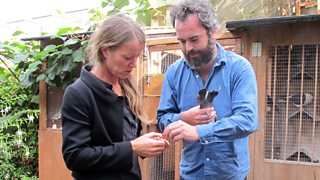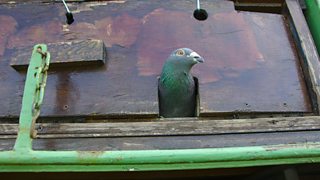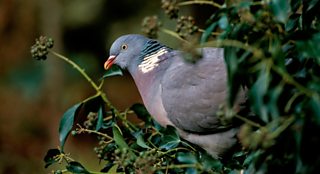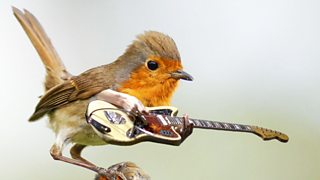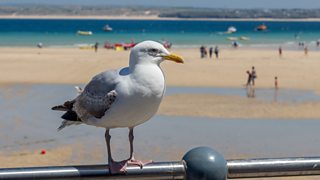The pigeon: Britain’s most misunderstood bird?
When we think of the pigeon, most of us envisage a dirty, straggly bird persistently getting a bit too close to our sandwich. For many, the bird is considered vermin – quite simply a 'rat with wings'. However, there’s more to the pigeon than meets the eye. In fact, we have a lot to thank them for. In Natural Histories, Brett Westwood and Verity Sharp probe into the world of the pigeon, exploring just how this feathered friend has helped us over the ages.
Here are some facts about the pigeon that might just change your mind about one of Britain’s most misunderstood birds.
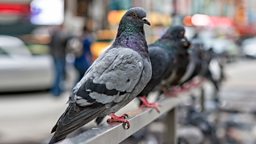
1. The pigeon is nature’s best messenger
Homing pigeons – a type of domestic pigeon descended from the rock pigeon – are extremely effective messengers because of their innate homing abilities, enabling them to return to their nest from miles away.
It’s not entirely clear how they do it – some think they use the sun; others believe it is magnetoreception (using the earth’s magnetic field and magnetic particles in their upper beak to map their position) and some even think they navigate using their sense of smell – quite literally following their nose (or rather beak).
Using pigeons to deliver messages is no new thing. In fact, pigeons were used to announce the winners of the Olympic Games some 3,000 years ago!
-
![]()
Natural Histories: Pigeon
One of our oldest companions, the pigeon inspires both love and loathing.
-
![]()
Open Country: The Secret Life of Pigeons
Do you know a Tippler from a Tumbler and a Grizzle from a Check pie?
2. They helped save thousands of lives during the World Wars
During the First and Second World War, homing pigeons were used to transport important messages back to their home coop behind the lines. When they landed a bell would sound to let soldiers know that a message had arrived.
These messages were often crucial – alerting the army to the enemy’s position or a need for further back up – and, as such, a pigeon's job was perilous. Enemy soldiers would try to shoot them down to prevent the messages from making it back to barracks.
These pigeons were so integral to the war effort that 32 of them were even presented with the Dickin Medal, honouring the work of animals in World War II.
The surprising bird thriving in gardens

We’re spending more and more time and money attracting birds to our gardens.
3. They can cover enormous distances at tremendous speeds
Pigeons can fly between 600 and 700 miles in a single day and flights of over 1,000 miles have been recorded by birds in competitive pigeon racing (when specially bred and trained birds are released from specific locations to race home). And they’re fast with it.
They may not seem it, but pigeons are incredibly intelligent creatures. They recognise themselves in reflections.
Top racers have been recorded flying at over 100 miles per hour.
These quick pigeons are highly coveted: earlier this year, a racing pigeon named Armando sold to a Chinese enthusiast for a world record £1.1 million!
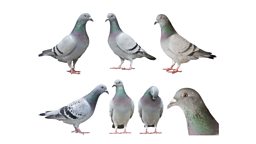
4. They helped Darwin with his theory of natural selection
Pigeons played a crucial role in the development of a hypothesis that changed the world: Darwin’s theory of evolution.
The scientist bred pigeons in his garden, experimenting by cross-breeding birds with different characteristics in order to generate different features in their offspring: longer legs, shorter beaks or darker plumage.
By artificially selecting in this way, Darwin gathered valuable evidence for his theory of evolution by natural selection.
-
![]()
Darwin: In Our Time
Melvyn Bragg presents a series about Darwin's life and work.
5. Pigeons pass the mirror test
They may not seem it, but pigeons are incredibly intelligent creatures. They are one of only a small number of species to pass the mirror test – a test that measures self-awareness by determining whether an animal can recognise its own reflection.
The only other animals to pass this test of self-recognition are chimpanzees, bonobos, orangutans, dolphins, elephants, and humans. Typically, birds will simply attack their own reflection – but not the pigeon.
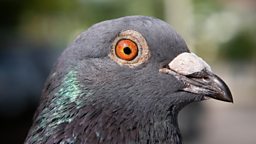
6. Pigeons believe in progressive parenting
Baby pigeons – known as squabs – stay in the nest and away from human eyes until they take on adult appearance.
Pigeons are big fans of co-parenting, with both mum and dad sharing the care for their chicks. They take it in turns incubating the eggs and this shared responsibility even goes as far as feeding the youngsters “milk”: both male and female pigeons produce a high fat and protein secretion used to nourish their offspring.
7. Pigeons are very private
Pigeons get everywhere: they swarm our streets and parks and pavements. And yet, have you ever seen a pigeon chick? The answer is almost definitely no. There are a couple of reasons for this.
Firstly, even our confident urban pigeons are very secretive when it comes to choosing a nest site. They hide them away on rooftops, church towers and abandoned buildings. And secondly, baby pigeons – known as squabs – stay in the nest and away from human eyes until they take on adult appearance.
Did you know a pigeon chick is actually yellow?
-
![]()
Tweet of the Day: Wood Pigeon
Michaela Strachan presents the story and sound of the wood pigeon.
-
![]()
Bird or Band Quiz
Test your knowledge by correctly identifying whether we've given you the name of a bird or the name of a band.
More from Radio 4
-
![]()
Natural Histories: Pigeon
One of our oldest companions, the pigeon inspires both love and loathing.
-
![]()
Seven of the world's most infamous animal invaders
From mammals to molluscs, here are seven of the world’s most troublesome animal invaders.
-
![]()
Seagull urban myths: fact or fiction?
Are any of the urban myths true surrounding the seagull and its Hitchcockian behaviours?
-
![]()
Eleven pawsome facts about dogs
Who's a good boy? We have the answer.
